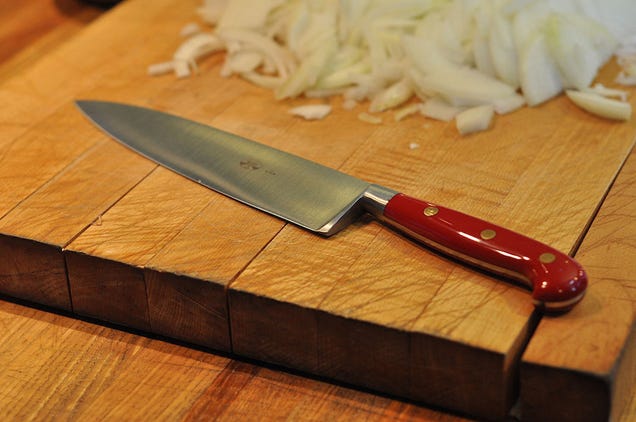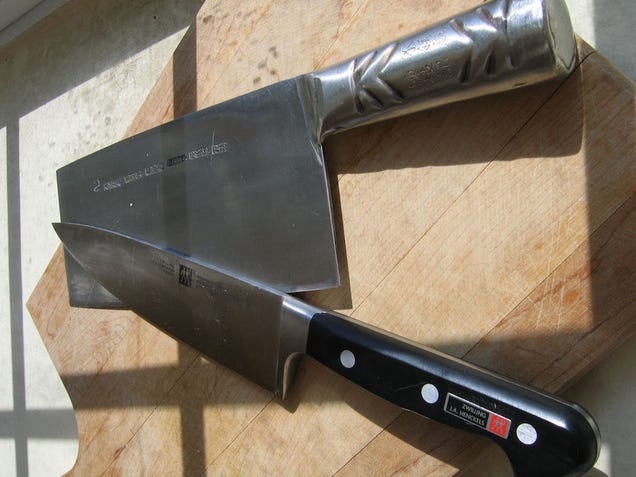Knife Sets Almost Always Mean Terrible Knives
Especially when you’re just moving out on your own or setting up a kitchen, buying a set of knives can seem like a good idea. For a decent price, you can get a bunch of knives, a honing steel, and a block to store them all in. Sounds good, right? The problem with knife sets is that they’re almost universally terrible. We touched on this a little bit before, but often manufacturers skimp on build quality, materials, size, and in some cases even blade geometry in order to produce a cheap product. They’re not designed to keep their edge in day to day use, to stand up to regular honings or even sharpenings, and they’re not designed to last. The video above from the folks at America’s Test Kitchen actually puts several sets to the test, and reinforces the point.
Knife sets are often packed with redundant knives you’ll never use, and maybe one or two you’ll use until it’s dull, when it becomes more of a hazard than a help. Even the ones you use may be poorly designed for their purpose. The serrated knives in knife sets are often too short, the “paring” knives or “utility” knives in knife sets are almost always too short for actual peeling or detailed use, and don’t forget the annoyance that comes with opening an “eight piece knife set” only to find out that two of the “pieces” are the knife block and the honing steel in the center, and you actually got six actual knives.
Long story short, for the money you spend on a knife set from a department or big box store, you can easily buy two or three great, versatile knives that will stand the test of time and keep their edge over regular, day-to-day use. After all, if you’re buying a set of eight—or rather, six knives and only using two or three of them anyway, wouldn’t it be better to save money and get two or three amazing knives instead?
The Knives You Need In Your Kitchen (and Should Buy Instead)
The “right” knives for your kitchen depends on the type of cooking you do, of course. However, there are a few multi-purpose knives that every home cook should have, just because they’re good at just about anything you throw at them. Here are the essentials you should definitely own:
- A 8” or 10” Chef’s Knife: Whether you get an 8” or a 10” here depends entirely on your kitchen working space and how comfortable you are with that size of knife. For me, I prefer an 8” knife unless I’m working with larger cuts of meat or huge, thick-rinded vegetables like melons or gourds, in which case the added length and leverage of a 10” chef’s knife can make a huge difference (although I own knives of both sizes.) You’ve heard us mention it before, but the Victorinox Fibrox 8” ($35) is a knife that punches way above its weight here, and the 10” Fibrox ($35) is no slouch either. If you need some more suggestions, this recent Kinja Co-Op has a few more.
- A 3” or 4” Paring Knife: From peeling vegetables and fruit to general light-duty jobs you don’t want to drag out a chef’s knife for, a good paring knife will probably be your go-to for just about anything that you say “I need a knife for this,” but don’t need a huge, sharp, dangerous knife for. You know the jobs. America’s Test Kitchen likes the Wusthof Classic 3.5” Paring Knife ($40), but if you’re sensing a theme, the Victorinox Swiss Army Fibrox 3.25” Paring Knife ($8) is a good second choice. You could argue that a peeler makes a paring knife useless, but I find them way too versatile to omit (and plus, learning to peel with a knife is a good skill to have.)
- A Long, Serrated Bread Knife: You might think that you can get away without a serrated utility or bread knife, and you probably could, but once you have one you’ll wonder how you lived without it. They’re not just for cutting bread, either—they’re also perfect for easily cutting through sandwiches, cuts of fatty meat, tomatoes, peaches, or just about anything else that’s firm on the outside and soft on the inside—or that has a body that can tear easily. You’ll want at least 10” of blade on your serrated knife and a little flexibility, as this America’s Test Kitchen review explains in detail Again, the 10” Victorinox Bread Knife ($40) was one of their favorite budget picks, delivering clean cuts, a long (4”) handle for easy grip. If you have cash though, the Wusthof 10” Classic Bread Knife ($120) was their clear favorite, but spending that much defeats the purpose of ditching a knife block and picking up good affordable knives instead, so we’re going with the budget pick here.
- A 7” or 8” Santoku: This is a bit of a personal choice, because I actually prefer the way that a Santoku handles compared to a chef’s knife for many tasks—usually for multipurpose slicing and for cutting vegetables, but I’ve found the Santoku’s snub-curved blade at the front of the knife and shorter body makes precision slicing and thin cuts easier for me. You may or may not agree, but I definitely have times when I prefer my Santoku to my Chef’s Knife, and vice versa. Again, Victorinox comes through with a great budget pick, the 7” Graton Edge Santoku ($37) that I personally bought back in 2009 and still use almost daily.
In Alton Brown’s Gear for Your Kitchen, he starts with most of these (sans Santoku, of course) and then explains where you should go from there, and offers a few knife suggestions of his own, if you’d like to read more. Similarly, our list of essentials is a little different from the oneour friends at Gizmodo put together, mostly because we’re aiming at essentials—knives you could easily buy with the money you saved on that knife block that’s on sale at your local department store.
The Knives You May Not Need, but Will Eventually Want
Speaking of Gizmodo’s list, once you have the knives above, here are some additional knives that you don’t need to have, but will certainly make specific tasks much much easier:
- A Carving or Slicing Knife: Don’t mistake this for a bread knife—a long, flexible, non-serrated blade like this Victorinox 12” slicing knife can mean the world between nice, even slices of ham, roast or corned beef, cake, or just about any solid-but-large hunk of food where you want even slices without tearing up the body with a serrated blade. You won’t carve poultry with one of these (you’ll probably use a chef’s knife, since the pointed tip is useful for getting between bones and joints.) However, anywhere else where a single, slicing motion is enough to cut through the entire thing—or where you need the length of a serrated knife without the pesky teeth—this is your go-to blade. Getting one was one of the best things I’ve done.
- A Meat Cleaver: Lots of lists include the meat cleaver as an essential, and we can kind of understand why, but it’s probably not required for someone on a budget or just getting started in the kitchen. You’ll probably have better control and leverage with a chef’s knife for those times you may be tempted to use a cleaver, and if you run into that many situations where a cleaver would be better, you probably know you need one anyway. Still, once you have the basics down, one of these can be a big help. For the adventurous, a Chinese cleaver that’s designed for both chopping and delicate slicing (compared to a heavier European-style meat cleavers) can pull triple duty in your kitchen for vegetable chopping and dicing (once you know your way around with one, finely chopping even dense vegetables like cabbages and carrots is a breeze), an impromptu bench scraper, and hammering through bones and joints of large cuts of meat. This $10 WINCO is a good starter model, as is this $17 Top Chef 7” cleaver if you want to try one, and this $50Henckels Classic 6” cleaver is a good option for the more traditional cook.
- A Filet or Boning Knife: Once you get in the habit of fileting your own fish or cutting up your own chicken, you’ll probably eventually want one of these. The super thin, narrow, flexible blade makes it easy to slip in between bones and joints in a way you just can’t do with a chef’s knife. Even if you’re not interested in boning your own fish or parting out a chicken, these knives are great for trimming the silverskin or excess fat from large cuts of meat, or trimming off thin skin from large fruits and veggies without forcing you to grab your (often shorter) paring knife. America’s Test KItchen and Cook’s Illustrated prefer the6” Victorinox Fibrox Boning Knife (sensing a theme here?) for $21.
- A Pair of Kitchen Shears: There’s a strong case to be made that these should be in the essentials list, but at some point or another, whether you need leverage getting through a joint when you’re parting our poultry, trimming or cutting stems, or you just need a versatile pair of scissors for opening packages, you’ll want kitchen shears. Ideally, you’ll want a pair that can be easily washed, that come apart into two pieces (but not so easily they’ll fall apart while you use them), and are easy to handle and grip even when your hands are messy. Henckels’ Take Apart Kitchen Shears are a good option for $15, as are the $10 Kitchen Aid Professional Shears, which I own and adore. America’s Test Kitchen also recommends the Messermeister 8.5” Take Apart Shears if you like the design and need more leverage (although lefties may not like them very much.)
If you’re tempted to buy a knife set for a friend—as a housewarming gift or a wedding present—do them a favor and assemble a “dream team” of some of these knives instead and pack them together yourself, maybe along with a nice honing steel like this 12” WINCO model for $10, orthis heavier-duty 12” Wusthof for $25. Trust us, your recipient will appreciate it more, and your gift will never collect dust in a cabinet or basement somewhere.
You could go crazy and get all of these—even the budget options—and spend way more than a knife set at your local department store. We get that, but if you stick to the essentials and go with the bang-for-the-buck options listed here, you’ll probably spend less and wind up with knives that’ll last you much, much longer and hold their edge longer before you need to sharpen them (or have them sharpened.) While you’re at it, make sure to store them on a magnetic knife rack, or at the very least somewhere not in the utensil drawer. Your knives will stay happy, you’ll have the tools for whatever you want to cook, you’ll have saved a bunch of money, and most importantly, you’ll be safe in the kitchen.


No comments:
Post a Comment